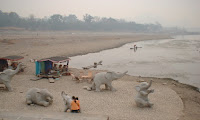Why do they? Whence the scenery, the mist, the absurdly beautiful mountains?
From what I understand, the mountains are the result of volcanic activity under limestone domes. The mist is due to the (non-rainy) season of our visit, sand blown from Tibetan deserts, and illegal surface mining and subsequent burning of soft coal.
Chinese art work has taught tourists that the place to see Guilin's landscape is from, or alongside, the Li River. Today, tourists go by motorboat, and the trip includes a meal cooked at the back of the boat.

While a meal cooks below them, Irene, Nettie, Lucy, and our tour companion Ester Martinez agree to pose.
On the Li River also is a famous rock anomaly, Elephant Trunk Hill.
For the tourists who come here, the Guilin elders understand that the ambient motif has to be elephants. The children's playscape
the bridges
and the benches
For tourists unexcited by elephants, the elders, knowing from their youth that the island facing Elephant Trunk Hill is a hangout for neckers, call it Love Island and fill it with embracing statues.

In Love Island's parking lot gather the trinket and fruit sellers and three young women from "ethnic minority" groups in their native costumes. For pocket change you can have your picture taken with them.
Guilin's limestone mountains are full of caves and grottoes, and we were taken to the most famous, Reed Flute Cave, so called because the reeds used for making flutes grow, or grew, by the cave mouth. I'm not a big cave lover, but this one is spectacular, a fact only hinted at in my pictures. (For overlit views of the cave, go to http://www.molon.de/galleries/China/Guanxi/Reed/).
For the tourists who come here, the Guilin elders understand that the ambient motif has to be elephants. The children's playscape
the bridges
and the benches
For tourists unexcited by elephants, the elders, knowing from their youth that the island facing Elephant Trunk Hill is a hangout for neckers, call it Love Island and fill it with embracing statues.

In Love Island's parking lot gather the trinket and fruit sellers and three young women from "ethnic minority" groups in their native costumes. For pocket change you can have your picture taken with them.
Guilin's limestone mountains are full of caves and grottoes, and we were taken to the most famous, Reed Flute Cave, so called because the reeds used for making flutes grow, or grew, by the cave mouth. I'm not a big cave lover, but this one is spectacular, a fact only hinted at in my pictures. (For overlit views of the cave, go to http://www.molon.de/galleries/China/Guanxi/Reed/).












No comments:
Post a Comment